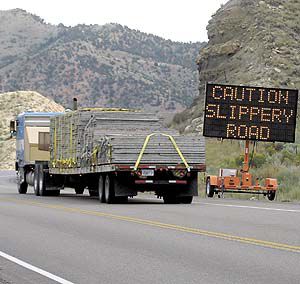| A temporary warning sign alerts motorists in Price Canyon of slick road conditions as they descend into Helper. Due to a number of factors, including the type of rock in pavement, the road now has a slippery surface, especially when wet, a condition which officials call unacceptable. The road is scheduled for maintenance work in September. A mid-week project slated to begin on Sept. 12 is expected to correct the problem. |
Drivers in Price Canyon will see orange in the fall as the Utah Department of Transportation undertakes a resurfacing project on U.S. Highway 6.
The three-day project, which is slated to begin on Sept. 12, will address safety issues on three miles of the highway.
The area scheduled for resurfacing is currently marked on both ends by temporary construction signs, which warn drivers to slow traveling speeds down to 45 miles per hour.
The three-mile stretch includes both the Peerless port of entry and the junction with U.S. Highway 191.
Since the road was resurfaced and particularly in recent months, a number of accidents have occurred on the highway.
Exact figures detailing how many accidents have occurred have not been released by UDOT. But members of the Price field office of the Utah Highway Patrol indicated that they have seen an increased frequency of accidents in the area.
“It seems to be slicker than it ought to be in rainstorms,” said Myron Lee, public involvement coordinator for UDOT.
According to Lee, problems with the roadway center around the type of rock which was used when the road was paved a couple of years ago.
After a road is resurfaced, a certain amount of wear is expected. As the wear occurs, rocks are generally worn down by a chipping action, which leaves rough edges and provides better traction for motor vehicles.
Instead of the expected chipping action, the rock has been polished. This has left smooth edges, which have led to what Lee called an unsafe condition for motorists.
Lee explained that contributing factors could include a bonded wearing course which was used when the road was resurfaced. The bonded course is intended to prolong the life of the road and reduce maintenance costs. Another factor could be the speed of traffic on the section of the road, which has a posted speed limit of 55 mph.
If any one of those three factors – type of rock, bonded wearing course or traffic speeds – were removed from the equation, the road would likely be in an acceptable state. Lee stated that other roads in the state have been built with similar specifications, but have lower speeds.
At the lower traffic speeds, similar roads have not experienced the polishing effect.
Lee also explained that the bonded wearing course has been used on other roads at the same or higher speed. But with a different type of rock in the asphalt, transportation officials have not seen the decline in traction.
However, with all three factors in the equation, the road has become slick.
“That’s not acceptable,” said Lee. “As a result we have put together this project.”
UDOT crews will place a slurry seal over the top of the roadway where the polishing has occurred adding a friction course to the road. Transportation officials expect this the adhere to the current surface and increase traction for motorists.
Motorists should expect to see some delays as crews work to correct the situation. Drivers are encouraged to slow down through construction zones, obeying lower speed limits and other traffic controls. Utah law also stipulates that fines for speeding double in work zones.

